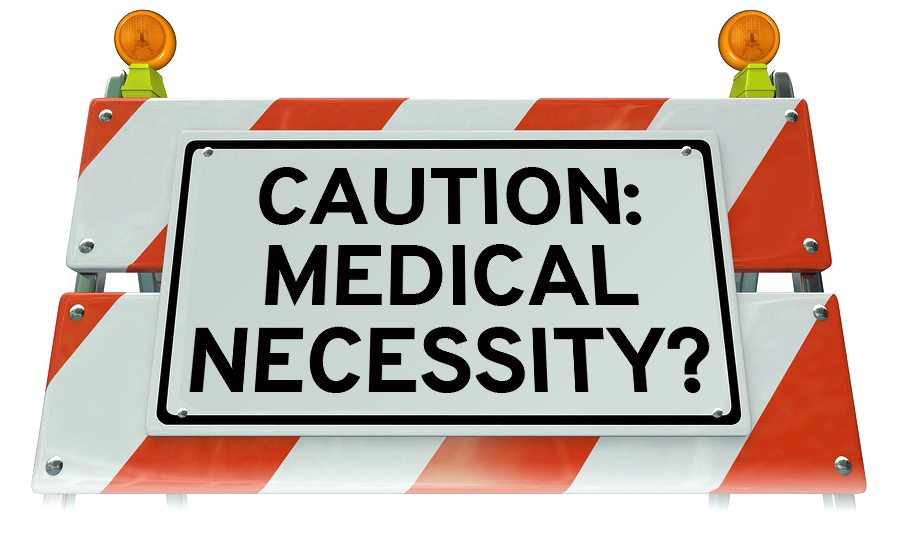Movement Barriers and Medical Necessity
Outside-the-Norm Questions
Our office receives questions from our EMS agency clients, periodically, regarding patients that have some kind of movement barrier connected to the treatment/transport scenario.
 These are the patients that have some sort of physical or structural challenge that exists between where they reside and the point where they can be loaded into a vehicle (wheelchair van, ambulance, car, etc.) to be transported to whatever treatment location they require to be transported to.
These are the patients that have some sort of physical or structural challenge that exists between where they reside and the point where they can be loaded into a vehicle (wheelchair van, ambulance, car, etc.) to be transported to whatever treatment location they require to be transported to.
These types of questions are outside-the-norm and require us to think a little harder about the resulting payment scenario which is why we are consulted on the billing side.
Ambulance versus Wheelchair
The questions we receive are typically concerning whether or not transfer barriers constitute medical necessity for ambulance transport. The questioning usually is posed because the patient requires additional personnel (more than one staff member assigned to a wheelchair van) and centers on whether the barrier makes the trip an ambulance trip that will result in Medicare and even some other insurance payers issuing payment for the trip in the end.
All About Medical Necessity
Where Medicare is concerned, the question always comes back to a medical necessity issue.
While we sometimes become sidetracked in our provider-heavy minds about the entire scenario, allow me to focus you back to this central factor.
It’s all about medical necessity!
Medicare pays for ambulance transports. The program in whatever form it takes DOES NOT pay for treatment, handling, peripherals… it pays for TRANSPORT! Period!
The defining medical necessity question to ask is…
Can my patient be safely transported in any other vehicle other than an ambulance without potential harming the patient?
It’s the foundation for all other discussion regarding payment.
The “Steps” dilemma…
Now that we’ve made that key point, let’s get back to the questioned scenarios.
Unfortunately, Medicare is not concerned that a patient has a zillion steps to navigate. How the patient moves from his/her residence or the place where he/she is to get to the vehicle that is going to transport the patient matters little to Medicare.
Because…it’s all about the transport and not how they eventually end up in that vehicle.
So, even if it takes two or three staff members to extricate the patient from the house to the transport vehicle, in the end if the patient can tolerate sitting in a wheelchair for the duration of the transport and he/she can be driven in a wheelchair van to his/her appointment without detriment to his/her health and well-being, then Medicare tells us they won’t pay for an ambulance ride. They will not agree to pay the resulting claim just because there are physical obstacles at the patient’s origin location.
Just because your EMS agency didn’t have an effective way to move the person to the wheelchair van because of the obstacles, doesn’t mean that suddenly the patient needs an extra attendant or two and a fully-equipped ambulance to take him to where he/she’s going.
Patient transfers…
Taking our discussion another way, we once answered a question for a client about an upcoming series of dialysis runs they were scheduling. The patient was moderately obese, wasn’t steady on his feet and the staff at the dialysis facility were limited in number so not physically able to handle an effective transfer of the patient from the wheelchair to the dialysis chair due to the patient’s weight.
Keep in mind, though, this patient that we’re discussing regularly spends hours in a wheelchair at the skilled nursing facility where he resides and had no complications that warranted the need for ambulance monitoring. The only reason the SNF was requesting an ambulance to transport the patient to his dialysis treatments was due to the fact that the SNF transport coordinator had communicated with the dialysis facility staff who stressed that the transfer of the patient from the wheelchair to the dialysis chair would not happen easily.
So, out went the resulting request for our client to schedule an ambulance to transport the patient instead of a wheelchair van.
After examining all the facts, our advice to the client was to suggest they contact the SNF to inform that the SNF would receive the bills for the transports within the framework of the preferred-provider agreement the client had in place with the facility. We advised this due to the fact that the patient did not fit the medical necessity criteria for Medicare to pay for the transport and basically the use of an ambulance was for convenience purposes.
The Final Takeaway…
If a patient is able to tolerate a wheelchair or is able to move about riding in cars or other similar types of vehicles without detriment to his/her overall health for the a length of time equal to the duration of the transport, then physical obstacles and difficult transfer scenarios aside, the patient is probably not medically necessary to justify Medicare payment.
Our best suggestion is to take a step back and consider the entire scenario when presented with these types of transport requests. As an EMS administrator, be sure to consult with your street staff, involve your billing office and other resources before making any final decision about what vehicle to use when these requests are received.
At Enhanced, we consults with our clients about these and many other issues to help them make decisions on how to best complete the transport scenarios they encounter.
Call us if you need assistance.
Current clients can reach out to Client Services for assistance in making a decision.